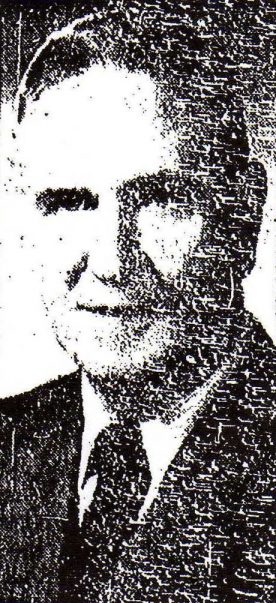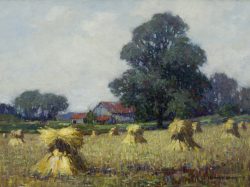J. Jeffrey Grant, from a photograph reproduced in Chicago Tribune, Aug. 11, 1957.

J. Jeffrey Grant 1883–1960
Born in Aberdeen, Scotland, James Jeffrey Grant was the son of an artist. He began painting at an early age and studied in his native city at the Gray School of Art, on a national scholarship. The Aberdeen Art Gallery exhibited one of his paintings when he was only seventeen years old. Grant moved to Canada in 1904 and worked as an engraver and sign painter. Three years later he arrived in Chicago, where he pursued further studies at the Art Institute of Chicago and at the Chicago Academy of Fine Arts (founded in 1902). Until 1920 Grant supported himself as an engraver while continuing to paint. In 1908 he joined the Palette and Chisel Club and he won a gold medal at its 1917 annual exhibition. In 1913 Grant made his debut in the Art Institute’s annual exhibitions for American artists and for Chicago-area artists; he was represented in one or both of those shows every year but one through 1949.
Early on, Grant established himself as a painter of marines and of females nudes “of a rather tepid type of female beauty,” according to Chicago Tribune critic Eleanor Jewett.i In the mid-1920s, however, his work gained new strength as he explored a wider variety of genres, including rural and urban landscape, still life, and portraiture. These shifts may reflect the impact of two return visits to Europe. In 1924 Grant painted in Scotland and France, particularly around Paris and in Brittany, and in 1926–1927 he studied with painter and teacher Moritz Heymann in Munich. In 1929, Grant discovered his favorite site for painting: the picturesque fishing town of Gloucester, Massachusetts. He found additional subjects in nearby Rockport and in Charleston, South Carolina; rural Illinois; and Chicago, among other locales.
Grant received a solo exhibition at the Art Institute in 1927. During the following decade, he was among the most successful painters in Chicago, winning several prizes in exhibitions at the Art Institute and the Chicago Galleries Association, among others. Beyond Chicago, he participated in exhibitions at the National Academy of Design in New York, the Pennsylvania Academy of the Fine Arts in Philadelphia, the Corcoran Gallery of Art in Washington, D.C., and elsewhere. His works were featured in a string of small group and solo shows, including two more at the Art Institute, and were widely praised and reproduced. “He speaks a strong, universal language, sure of being understood and appreciated by the public,” was a typical assessment.ii Grant combined a decorative use of color and patterned brushwork with accessible everyday subject matter. He was active in such conservative artists’ organizations as the Association of Chicago Painters and Sculptors and the Palette and Chisel Club, serving several terms as president of the latter. Grant continued painting and exhibiting his work until the year before his death at age seventy-seven.
Wendy Greenhouse, PhD
i Eleanor Jewett, “Grant and Grigware Win Highest Praise,” Chicago Tribune, Aug. 21, 1927.
ii J. Jeffrey Grant One-Man Show Has Appeal for Many,” Rockford Star, Aug. 7, 1927.
